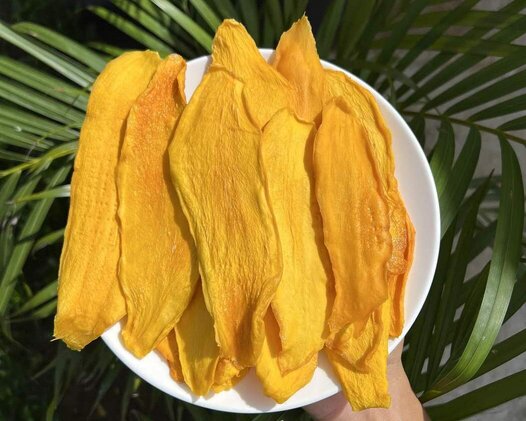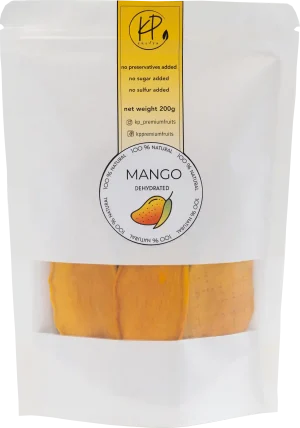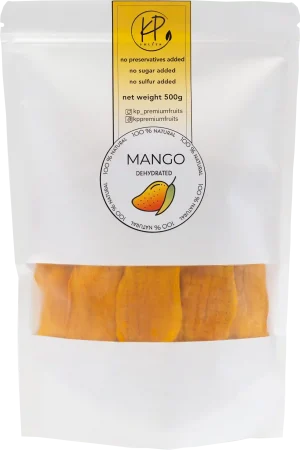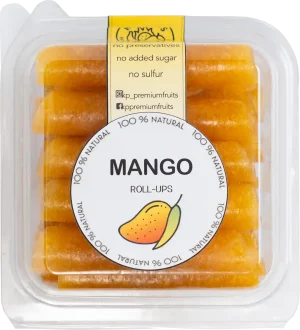The global fruit trade market continues booming. And dried mango keeps its dominant positions on it. Let’s dive into the key reasons why.
The story of dried fruits isn’t new. However, over the past several years the global trade of dehydrated mango, pineapple and other fruit has accelerated a lot, with new producers in the ASEAN region, e.g. in Thailand, joining the competitive race.
Namely, in 2021-2022 the production volume of dried fruits worldwide has grown by 3% YoY to 3.1 Billion metric tons (per Statista), and this trend is likely to continue. The dried mango Thailand export alone demonstrates its steadily growing volumes year over year, to some extent fueled by the increasing number of local organic farmers working the niche.
But why has dry mango gotten so popular among consumers after all?
Dried mango benefits
The answer is simple and complex, all at the same time.
First, the soft dried mango snack is delicious. Second, it’s nutritious. And third, it includes a great number of components, which prove beneficial for one’s health.
Rich in dietary fiber and Vitamins A and E, this dehydrated fruit is also a good source of iron and selenium, which helps keep the bones strong, improves the eyesight and enables maintaining the decent digestive and hormonal health levels.
More importantly, dried mango is packed with polyphenols and antioxidants, hence famous for its anti-inflammatory and even anti-carcinogenic properties. In plain words, its moderate consumption helps prevent the development of acute and chronic diseases, including cancer, atherosclerosis and diabetes, while also reducing the risks of having a stroke or a heart attack.
Last but not least, whether you decide to buy dried mango, or dehydrate it yourself at home, its key benefits remain pretty much the same.
Do the nutritional properties of dehydrated mango fruits, described above, sound too good to be true? If so, here’s a pinch of its downsides to consider.
It does include substantial amounts of sugar inside, so while eating dried mango no sugar should be added to the fruit (or its coating). More importantly, given that it includes 60 Kkal per 100 gr, keeping the daily eaten portions moderate is vital, especially if you’re cautious about your weight.
How to select the best dried mango?
First and foremost, as mentioned above, search for words, like “mango dried no sugar” on the package, which means that no extra sugar has been added to the fruit during the dehydration process.
Second, select organic dried mango fruit, rather than the plain, non-organic alternative. Why so? The organic product does not include preservatives or sulfurs, which yes, can prolong its shelf life, but definitely don’t make it healthier.
Tip! If you wish to find and buy the best dried mango Thailand can offer, KP Fruits would be a perfect choice to consider. Check out our one-stop shop and select the most delicious snack for you – right now!
Recipe of the Day – Energy Bites with Dried Mango
Ingredients:
1.2 cups of walnuts and/or cashews (raw)
1 cup of dried, unsweetened mango
10 pitted dates (whole)
Lime juice (from 1 small lime)
1 pinch of sea salt
0.25 cups of shredded coconut (for coating)
Instructions:
- Roast the nuts on a baking sheet in the oven (pre-heated to ~176 degrees Celsius) for 8 -11 minutes (until they get the light golden color).
- Meanwhile, make the dried mango soft by soaking it in the water in a mixing bowl for ~5-6 minutes, then drain it and remove excess water with a paper towel.
- Mix the toasted nuts in a food processor, then sit them aside.
- Mix dried mango with dates in a food processor (until you get somewhat a rough paste), then add a nut mix, along with lime juice and a pinch of sea salt.
- When finely mixed, take a Tbsp of dough, roll it in a small ball, then coat it in the shredded coconut.
- Repeat until you’ve used all the dough, and enjoy!
-
Dried Mango 200g
Original price was: ฿ 356.฿ 186Current price is: ฿ 186. -
Dried Mango 500g
Original price was: ฿ 980.฿ 465Current price is: ฿ 465. -
Dried mango roll-ups
฿ 59 – ฿ 89



